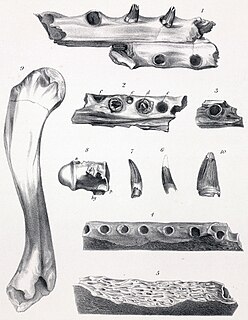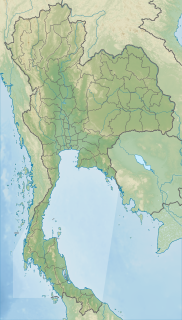
Gastornis is an extinct genus of large flightless birds that lived during the late Paleocene and Eocene epochs of the Cenozoic era. The genus is currently thought to contain three or four distinct species, known from incomplete fossil remains, found in western-central Europe. More complete specimens are known from a fourth, North American species, which had previously been classified in the distinct genus Diatryma. Many scientists now consider Diatryma to be so similar to the other species of Gastornis that it should also be included in that genus. A fifth species, also previously classified in its own genus, is known from China.

Siamosaurus is a genus of spinosaurid dinosaur that lived in what is now known as Thailand during the Early Cretaceous period and is the first reported spinosaurid from Asia. It is confidently known only from tooth fossils; the first were found in the Sao Khua Formation, with more teeth later recovered from the younger Khok Kruat Formation. The type species Siamosaurus suteethorni, whose name honours Thai palaeontologist Varavudh Suteethorn, was formally described in 1986. In 2009, four teeth from China previously attributed to a pliosaur—under the species "Sinopliosaurus" fusuiensis—were identified as those of a spinosaurid, possibly Siamosaurus. It is yet to be determined if two partial spinosaurid skeletons from Thailand and an isolated tooth from Japan also belong to Siamosaurus.

Iberosuchus is a genus of extinct sebecosuchian mesoeucrocodylian found in Western Europe from the Eocene. Remains from Portugal was described in 1975 by Antunes as a sebecosuchian crocodilian. This genus has one species: I. macrodon. Iberosuchus was a carnivore, unlike the crocodilians today, they are not aquatic and are instead terrestrial.
Procaimanoidea is an extinct genus of alligatorid from the Eocene of North America. It was named posthumously in 1946 by Charles W. Gilmore; the type species is P. utahensis, from the Uintan of Utah. It is based on USNM 15996, a nearly complete skull and partial left hind leg. A second species, P. kayi, was named in 1941 by C.C. Mook as a species of Hassiacosuchus, for remains from the Bridgerian of Wyoming. It was reassigned to Procaimanoidea in 1967 by Wassersug and Hecht. Procaimanoidea was a small alligatorid, and slightly heterodont, the last four teeth on each side of the jaws having blunt tips.
Arabemys is an extinct genus of sea turtle. It was first named in 1999, and contains one species, A. crassiscutata. It is known from deposits of Late Paleocene or Early Eocene age near the village of Linah in northern Saudi Arabia.

Langstonia is an extinct genus of notosuchian crocodylomorph of the family Sebecidae. It lived in the middle Miocene, in the "Monkey Beds" of the Colombian Villavieja Formation. Langstonia was named in 2007 by Alfredo Paolillo and Omar Linares for fossils originally described by Langston in 1965 as Sebecus huilensis. Thus, the type species is L. huilensis.(Paolillo & Linares 2007)

Bergisuchus is an extinct genus of small sebecosuchian mesoeucrocodylian known primarily from the Eocene Messel Pit in Germany. Few fossils of Bergisuchus have been discovered, only a single incomplete snout, a few partial lower jaws and some teeth. Despite being fragmentary, the jaw bones are enough to indicate that Bergisuchus had a short, deep, narrow snout and serrated teeth, quite unlike the broad flat snouts of modern crocodylians.

Dollosuchus is an extinct tomistomine originally named as a species of Gavialis. It is a basal form possibly related to Kentisuchus, according to several phylogenetic analyses that have been conducted in recent years, and is the oldest known tomistomine to date. Fossils have been found from Belgium and the United Kingdom. It had large supratemporal fenestrae in relation to its orbits, similar to Kentisuchus and Thecachampsa.
Eogavialis is an extinct genus of eusuchian crocodylomorph, usually regarded as a gavialoid crocodylian. It superficially resembles Tomistoma schlegelii, the extant false gharial, and consequently material from the genus was originally referred to Tomistoma. Indeed, it was not until 1982 that the name Eogavialis was constructed after it was realised that the specimens were from a more basal form.
Euthecodon is an extinct genus of long-snouted crocodyline crocodilians. It was common throughout much of Africa during the Neogene, with fossils being especially common in Kenya. It existed from the Early Miocene to the Early Pleistocene.

Sebecus is an extinct genus of sebecid crocodylomorph from Eocene of South America. Fossils have been found in among others Patagonia. Like other sebecosuchians, it was entirely terrestrial and carnivorous. The genus is currently represented by a single species, the type S. icaeorhinus. Several other species have been referred to Sebecus, but were later reclassified as their own genera.
Phosphatosaurus is an extinct genus of dyrosaurid crocodylomorph. It existed during the early Eocene, with fossils having been found from North Africa in Tunisia and Mali. Named in 1955, Phosphatosaurus is a monotypic genus; the type species is P. gavialoides. A specimen has been discovered from Niger, but it cannot be classified at the species level.

"Crocodylus" affinis is an extinct species of crocodyloid from the Eocene of Wyoming. Fossils were first described from the Bridger Formation by American paleontologist Othniel Charles Marsh in 1871. Marsh described the species, along with every other species of crocodyloid in the Bridger Formation, under the genus Crocodylus. The known specimen of "Crocodylus" affinis is a skull found at Grizzly Buttes, Wyoming, measuring 13 inches in length on the upper surface. Recent phylogenetic studies of crocodyloids show that "C." affinis is not a species of Crocodylus, but a genus has not yet been erected to include the species. Other Bridger species such as Crocodylus clavis and Brachyuranochampsa zangerli have been synonymized with "C." affinis.

The Khok Kruat Formation is a rock formation found in northeastern Thailand. It is the uppermost formation of the Khorat Group. It is dated to the Aptian stage of the Early Cretaceous period, and is notable for its fossils of dinosaurs. It is equivalent to the Gres superieurs Formation of Laos. The group is a fluvial formation consisting primarily of red siltstones and sandstones.

Tethysuchia is an extinct clade of neosuchian mesoeucrocodylian crocodylomorphs from the late Middle Jurassic to the Early Eocene of Asia, Europe, North America and South America. It was named by the French paleontologist Eric Buffetaut in 1982 as a suborder. Tethysuchia was considered to be a synonym of Dyrosauridae or Pholidosauridae for many years. In most phylogenetic analyses the node Dyrosauridae+Pholidosauridae was strongly supported. De Andrade et al. (2011) suggested that Tethysuchia be resurrected for that node. They defined it as a node-based taxon "composed of Pholidosaurus purbeckensis and Dyrosaurus phosphaticus, their common ancestor and all its descendants". In their analysis they found that the support for Tethysuchia is actually stronger than the support for Thalattosuchia. The following cladogram shows the position of Tethysuchia among the Neosuchia sensu this study.
Vivian de Buffrénil is a French histologist and paleobiologist who has been working at the Muséum National d'Histoire Naturelle in Paris since 1982. His doctorate (1980) and his doctorat d'état (1990), a diploma now replaced by the habilitation, were supervised by Armand de Ricqlès. His main fields of interest include basic histological descriptions, growth dynamics as recorded in bone growth marks, and adaptation of the tetrapod skeleton to a secondarily aquatic lifestyle. He is also interested in life history and population dynamics of exploited or threatened reptile taxa, especially among Varanidae and Crocodilia. He has published at least 92 papers, including 76 research papers, 10 reports on exploited or threatened species, and six popular papers.

Chalawan is an extinct genus of pholidosaurid mesoeucrocodylian known from the Early Cretaceous Phu Kradung Formation of Nong Bua Lamphu Province, northeastern Thailand. It contains a single species, Chalawan thailandicus, with Chalawan shartegensis as a possible second species.

Coelognathosuchia is an extinct clade of neosuchian crocodyliforms that includes Goniopholididae, Paluxysuchidae and Pholidosauridae, two families of superficially crocodile-like aquatic crocodyliforms from the Mesozoic. Martin et al. (2014) named the clade after finding goniopholidids and pholidosaurids to group together in their phylogenetic analysis of crocodyliform evolutionary relationships. In their analysis, Pholidosauridae was monophyletic and Goniopholididae was paraphyletic, being an assemblage of successively more basal taxa within Coelognathosuchia. Coelognathosuchia itself was positioned near the base of the larger clade Neosuchia as the sister group to a clade containing the Early Cretaceous neosuchian Bernissartia and Eusuchia, the group that includes all modern crocodilians and their closest extinct relatives.

Maomingosuchus is an extinct genus of tomistomine from Late Eocene (Priabonian)-aged deposits of China and possibly also Thailand. The type species, "Tomistoma petrolica" was named in 1958 and was redescribed as Maomingosuchus in 2017.
Éric Buffetaut is a French paleontologist, author and researcher at the Centre national de la recherche scientifique since 1976 where he is a Doctor of Science and Director of Research. Buffetaut is a specialist of fossil archosaurs, mainly dinosaurs and pterosaurs, and has published many books on paleontology. He is one of the major paleontologists to support the thesis of the fall of a meteorite as the main cause of the Cretaceous–Paleogene extinction event.















